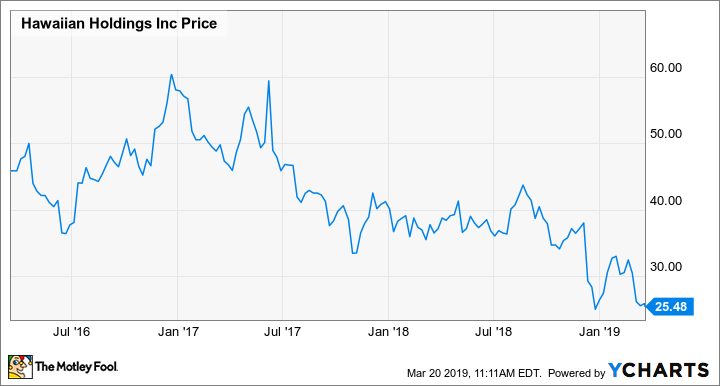How Hawaiian Airlines Is Responding to Southwest's Hawaii Invasion
Earlier this week, Southwest Airlines (NYSE: LUV) completed its first revenue flight from the West Coast to Hawaii, injecting new competition into Hawaiian Holdings' (NASDAQ: HA) biggest market. Next month, it will begin operating inter-island flights, giving Hawaiian Airlines a serious rival in its home market for the first time in several years.
The perceived threat from Southwest -- and rising competition more broadly -- has sent Hawaiian Holdings' share price into a tailspin. The stock has lost nearly a third of its value over the past year, and it now trades more than 50% below the all-time high of around $60 it reached in late 2016.
Hawaiian Holdings Stock Performance, data by YCharts.
However, Hawaiian Airlines has a greater ability to withstand Southwest's incursion than many investors seem to realize. Here's how it's responding to the low-fare airline giant's expansion plans.
What's already happened
Hawaiian Airlines hasn't just been standing still and hoping for the best. Even before Southwest's first Hawaii flight, it had already made some important changes that should help shore up its profitability.
Most notably, Hawaiian retired its fleet of aging Boeing 767s earlier this year, and replaced them with Airbus A321neos. The new planes are about 25% smaller, far more fuel efficient, and -- in Hawaiian Airlines' configuration -- have a significantly higher proportion of first class and extra-legroom seats.
Hawaiian Airlines is now flying only A321neos on about a dozen routes, most of them serving the four California cities that Southwest has identified as its initial California-to-Hawaii gateways: Oakland, San Jose, Sacramento, and San Diego.
In other words, the airline pre-emptively reduced its capacity in many of the markets where it's about to face competition from Southwest. For example, total industry capacity on the Oakland-Honolulu route -- Southwest's first to Hawaii -- was nearly 18% lower year over year in January (the most recent month for which statistics are available). Industry capacity was also down by double-digit percentages on the Oakland-Maui, San Jose-Honolulu, and San Jose-Maui routes -- the next three West Coast-Hawaii routes that Southwest will begin flying.

Hawaiian Airlines has cut capacity on many of the routes Southwest will serve. Image source: Hawaiian Airlines.
As a result, these markets won't suffer from significant overcapacity as Southwest's flight schedule ramps up. Additionally, because premium seats now account for a greater proportion of its capacity, Hawaiian Airlines will be able to appeal to a demographic that Southwest doesn't really serve. Both factors should limit the impact of Southwest's growth on Hawaiian's unit revenue.
Pursuing growth outside of Southwest's gateway cities
While Hawaiian Airlines has been reducing its capacity on some routes by switching to the A321neo, it doesn't want to shrink overall. That means it needs to find other ways to grow.
It's doing just that. Next month, it will launch nonstop service to Boston, becoming the first airline flying between Boston and Honolulu. The carrier also recently announced that it will add a second daily flight (using an A321neo) between San Francisco and Honolulu in October, taking advantage of a market where industry capacity is now declining after huge growth in 2018. The new flight is geared toward customers who want to maximize their time in Hawaii, with an early-morning departure from San Francisco and a red-eye return flight.
Additionally, it is aggressively pursuing additional slots at Tokyo's Haneda Airport, from which it already operates two round-trips a day. Haneda is the most convenient airport for the majority of Tokyo residents. Moreover, Hawaiian believes that increasing the frequency of its arrivals will enable it to unlock synergies with partner Japan Airlines, because it will be able to offer more natural connections to dozens of other Japanese cities via Haneda Airport.
Basic economy will make price-matching easier
Finally, Hawaiian Airlines will follow most of its peers by introducing basic economy fares later this year. Customers who chose this new, lower-price tier will not be able to select their seats in advance nor make flight changes, and customers holding Main Cabin Basic tickets will board last. The first restriction is likely to be viewed as the most significant, as it means that families wouldn't be guaranteed to get seats together.
At first glance, a stripped-down fare might seem like a strange way to compete with Southwest, which famously has no bag fees (for the first two checked bags, anyway), no change fees, and open seating. However, many travelers are motivated by getting the lowest possible base fare. The basic economy fares will enable Hawaiian to match or even beat Southwest's prices -- and advertise that fact -- but then generate extra revenue from customers upgrading to standard economy fares.
Thus, Hawaiian Airlines is shifting capacity to markets where it won't be competing directly with Southwest (for now, at least), while reducing its costs and improving its revenue-generating capabilities in the markets where it will. The results of these efforts could spark a big rebound for Hawaiian Airlines stock over the next year or two.
More From The Motley Fool
Adam Levine-Weinberg owns shares of Hawaiian Holdings and Southwest Airlines. The Motley Fool owns shares of and recommends Southwest Airlines. The Motley Fool recommends Hawaiian Holdings. The Motley Fool has a disclosure policy.

 Yahoo Finance
Yahoo Finance 
